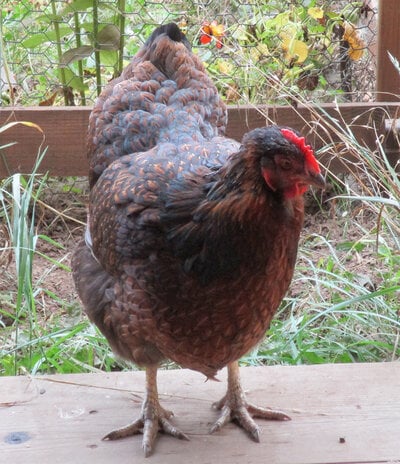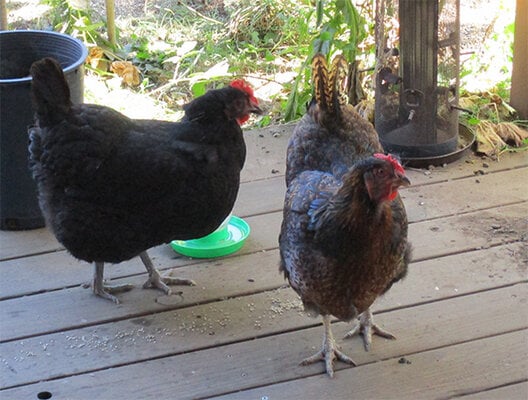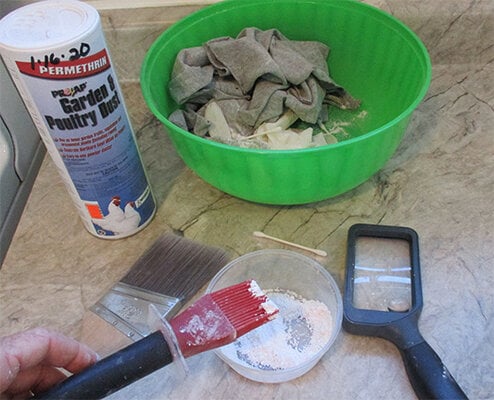flyinferg
Chirping
Two questions related to mites and crusty butt:
Hello folks, I read through a variety of forums but I did not find specific info regarding these two issues. I have only two chickens, one is an older (7 ish) pet hen who I have had for three years. And two years ago, I got a four-year-old rescue hen who is slowly adjusting to life outside of a small crowded cage.
1). Why is my hen shaking her head?
The older hen, Nancy, has been lightly shaking her head for a few months. Every 15 to 25 seconds, for a few seconds at a time. First, I thought it was her molting style. She stops laying the occasional egg and casually sheds about a hundred feathers over a four-month period. I checked her head for mites a month ago. I finally found two, one on the back of her neck and one an inch below her ear. I dusted her carefully with Permethrin, by hand, around her neck and as close to her orifices as I felt was safe, about an inch and a half, from ears/beak/eyes. I vacuumed out the shavings from the floor of their moderately sized coop and dusted all surfaces with food grade diatomaceous earth. A week later, I did not see any mites near her head. I lightly dusted under her wings/armpits. Just to be on the safe side. A week later I noticed a few tiny mites around her vent area. Thoughts on head-shaking. Is it bug related?
2). Here is the second issue. I went ahead and dusted her vent area, reapplied a dusting of Permethrin to their perch. She always has a bit of a crusty butt and every four or five months we would have a spa day and I would carefully ease off the crust with a warm water-soaked rag. She liked it and stayed fresh for a month or so.
My second question is: Shall I address the mites around her vent with the Permethrin first – or soak off her crusty butt first ?
P.S. I adore my two later-in-life surprise “children”. They are constant company while I putter around my town sized yard with lots of natives and volunteer plants happily growing freely. Any and all suggestions/input welcome. Ever so grateful that you folks share your experience and information.
Hello folks, I read through a variety of forums but I did not find specific info regarding these two issues. I have only two chickens, one is an older (7 ish) pet hen who I have had for three years. And two years ago, I got a four-year-old rescue hen who is slowly adjusting to life outside of a small crowded cage.
1). Why is my hen shaking her head?
The older hen, Nancy, has been lightly shaking her head for a few months. Every 15 to 25 seconds, for a few seconds at a time. First, I thought it was her molting style. She stops laying the occasional egg and casually sheds about a hundred feathers over a four-month period. I checked her head for mites a month ago. I finally found two, one on the back of her neck and one an inch below her ear. I dusted her carefully with Permethrin, by hand, around her neck and as close to her orifices as I felt was safe, about an inch and a half, from ears/beak/eyes. I vacuumed out the shavings from the floor of their moderately sized coop and dusted all surfaces with food grade diatomaceous earth. A week later, I did not see any mites near her head. I lightly dusted under her wings/armpits. Just to be on the safe side. A week later I noticed a few tiny mites around her vent area. Thoughts on head-shaking. Is it bug related?
2). Here is the second issue. I went ahead and dusted her vent area, reapplied a dusting of Permethrin to their perch. She always has a bit of a crusty butt and every four or five months we would have a spa day and I would carefully ease off the crust with a warm water-soaked rag. She liked it and stayed fresh for a month or so.
My second question is: Shall I address the mites around her vent with the Permethrin first – or soak off her crusty butt first ?
P.S. I adore my two later-in-life surprise “children”. They are constant company while I putter around my town sized yard with lots of natives and volunteer plants happily growing freely. Any and all suggestions/input welcome. Ever so grateful that you folks share your experience and information.







